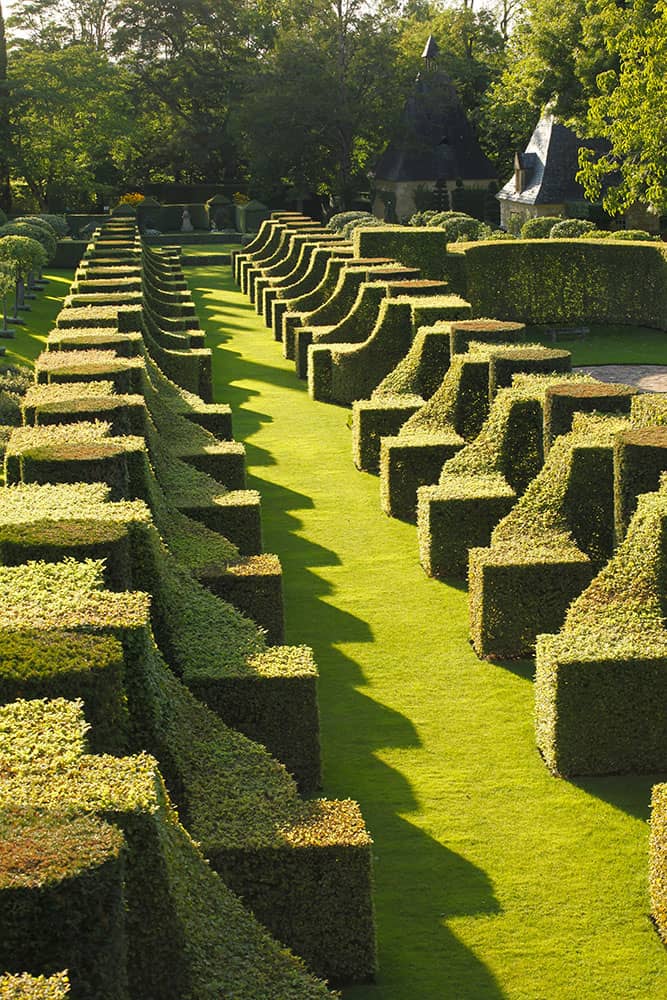A celebration of Topiary Art
at the gardens of the Manor of Eyrignac
Garden art
The seven gardens of the Manor of Eyrignac are reason-enough to visit but if there is an eighth wonder to discover here, it is the evergreen shrubs, called topiaries, artistically carved by the hand of the gardener. With various shapes and uses, arranged with harmony, these architectures, sculptures and lively patterns punctuate the walk and arouse the astonishment and admiration of the visitor who attends Eyrignac to the spectacle of nature brought to a high degree of perfection by an ancestral gesture.
Topiary art is a horticultural discipline practiced since Antiquity which is unique in having crossed all modes of gardening. Topiary art requires patience and skill from the gardener; sculpting the plant material requires a number of hours to materialize the projected shape and then requires regular maintenance to preserve the design. The so-called Sempervirens species, such as boxwood or yew, but also hornbeam and ivy, are preferred for pruning using shears, cords, plumb lines and templates.
Plant architecture structures the space
A garden is, by definition, a space structured by human thought. In order to make his guidelines readable, to give volume to his drawing, to create contrasts between shadow and light, the gardener exploits all the potentialities of the plant material by varying its shapes, dimensions and colors. He elevates the hedges of greenery taller or shorter, thinner or thicker, straight and curved, thus emphasizing the axis and layout in areas such as the Allée des Charmes or the Chambre de Verdure in Eyrignac, where the structures resemble green buildings. It is only at the cost of rigorous, regular pruning that the illusion of this green architecture can be maintained.
The gardener sculpts nature
Sculpting living matter is something that has been effected by the gardener since Roman Antiquity. The basic shapes are geometric shapes – sphere, cube, cone, pyramid, spiral – which, depending on the skill of the gardener, can become more complex at will, sometimes reaching monumental dimensions. In this regard, the topiaries of the Manoir d´Eyrignac erected in the Jardin des Sculptures Végétales and in the French Garden are particularly remarkable.
The gardener can also break free from classic shapes and indulge in the freedom of his own ideas. The subject of his choice then comes to fruition whether it be objects, animals or characters. In Eyrignac, charming birds, rabbits and green foxes frolic throughout the year in the flowery meadows.
Topiary art, work and framework of the spectacle of nature
Topiary art is not limited to monumental creations, it is also suitable for the execution of ornaments with delicate patterns like, for example, the embroidery beds typical of the French garden which can be admired from the first floor. Various materials can be used to make these patterns – grass, crushed bricks, river sand, etc. In Eyrignac, the traditional arabesque motif of the French parterre was drawn with boxwood.
In the White Garden, of refined inspiration, topiary art is less spectacular; it is the setting for the gushing of water and flowering: the four peripheral fountains are set with a plant ornament carved in the shape of a star, remarkable for its simplicity the white flowers stand out against a background of perennial greenery.
Green architectures, plant sculptures, ornamental motifs, are all elements that show that making a topiary is indeed an art and one which finds itself in the gardens of the Manoir d’Eyrignac; a limitless place of expression.

